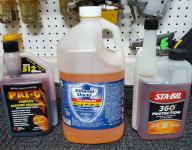GearHead36
Well-Known Member
- Joined
- Apr 26, 2023
- Threads
- 23
- Messages
- 335
I have a Champion generator, which, of course, doesn't get used that often. The manual has 3 storage procedures. One for short term (up to 30 days), one for mid term (30 days to 1 yr), and one for long term (more than 1 yr). I always use the long term procedure. I say "always", but so far, that's only been two times. I bought it for hurricane Helene, so it's less than a year old. The long term procedure is:
- Open fuel valve
- Unscrew fuel drain screw on carb. This will empty the contents of the fuel tank and carb bowl through a tube out the bottom of the generator.
- Remove spark plug
- Put 1 tbsp of oil in cylinder
- Slowly pull the starter rope one time.
- Reinstall spark plug
- Screw fuel drain screw back in.
I did this after Helene, then needed it again 9 months later. I put fresh ethanol-free fuel in it, and it fired right up just like it did when new. The manual doesn't say to run it until it dies, but that wound up happening both times I've done the storage procedure. I usually run the generator until it runs out of gas, then check to see if the power has been restored. I don't know if running it until it dies makes a difference. Admittedly, it only sit for 9 months, but Champion claims that this procedure, which doesn't include putting anything in the carb, is good for long term storage. Champion also recommends ethanol-free fuel.
- Open fuel valve
- Unscrew fuel drain screw on carb. This will empty the contents of the fuel tank and carb bowl through a tube out the bottom of the generator.
- Remove spark plug
- Put 1 tbsp of oil in cylinder
- Slowly pull the starter rope one time.
- Reinstall spark plug
- Screw fuel drain screw back in.
I did this after Helene, then needed it again 9 months later. I put fresh ethanol-free fuel in it, and it fired right up just like it did when new. The manual doesn't say to run it until it dies, but that wound up happening both times I've done the storage procedure. I usually run the generator until it runs out of gas, then check to see if the power has been restored. I don't know if running it until it dies makes a difference. Admittedly, it only sit for 9 months, but Champion claims that this procedure, which doesn't include putting anything in the carb, is good for long term storage. Champion also recommends ethanol-free fuel.

